Decapeptyl Sr 22.5Mg Powder And Solvent For Suspension For Injection.
Package leaflet: Information for the user
* Decapeptyl® SR 22.5 mg
powder and solvent for suspension for injection
Triptorelin
Read all of this leaflet carefully before you start using this medicine because it contains important information for you.
• Keep this leaflet. You may need to read it again.
• If you have any further questions, ask your doctor, pharmacist or nurse.
• This medicine has been prescribed for you only. Do not pass it on to others. It may harm them, even if their signs of illness are the same as yours.
• If you get any side effects talk to your doctor, pharmacist or nurse. This includes any possible side effects not listed in this leaflet. See section 4.
What is in this leaflet
1. What Decapeptyl SR 22.5 mg is and what it is used for
2. What you need to know before you use Decapeptyl SR 22.5 mg
3. How to use Decapeptyl SR 22.5 mg
4. Possible side effects
5. How to store Decapeptyl SR 22.5 mg
6. Contents of the pack and other information
1. What Decapeptyl SR 22.5 mg is and what it is used for
Decapeptyl SR 22.5 mg contains triptorelin, which is similar to a hormone called gonadotropin releasing hormone (GnRH). Triptorelin belongs to a group of medicines called GnRH agonists. It is a long acting formulation designed to slowly deliver 22.5 mg of triptorelin over a 6-month period. It acts by lowering the levels of the male hormone, testosterone, in the body.
Decapeptyl SR 22.5 mg is used to treat prostate cancer.
Decapeptyl SR is available in two other strengths: Decapeptyl SR 3 mg is used once a month and Decapeptyl SR 11.25 mg is used once every 3 months. Ask your doctor if you would like to discuss changing your treatment.
2. What you need to know before you use Decapeptyl SR 22.5 mg
Do not use Decapeptyl SR 22.5 mg
• If you are allergic (hypersensitive) to triptorelin pamoate, gonadotropin releasing hormone (GnRH), other GnRH agonists or any of the ingredients of this medicine (listed in section 6).
Warnings and precautions
• There have been reports of depression in patients taking Decapeptyl SR 22.5 mg, which may be severe. If you are taking Decapeptyl SR 22.5 mg, and develop depressed mood, inform your doctor.
• If you are using medicines for preventing your blood clotting, since you may experience bruising at the site of injection.
• At the beginning of treatment there will be an increased amount of testosterone in your body. This may cause the symptoms of the cancer to worsen. Contact your doctor if this happens. The doctor may give you some medicine (an anti-androgen) to prevent your symptoms from getting worse.
• During the first weeks of treatment, Decapeptyl SR 22.5 mg may, as with other GnRH agonists, in isolated cases, cause the spinal cord to compress or the urethera (where you pass urine) to block. You will be monitored by your doctor and given treatment for these conditions if they occur.
• Treatment with Decapeptyl SR 22.5 mg, as with other GnRH agonists, may increase the risk of developing thin or weak bones, especially if you are a heavy drinker, a smoker, have a family history of osteoporosis (a condition that affects the strength of your bones), have a poor diet or take anticonvulsants (medicines for epilepsy or fits) or corticosteroids (steroids). If you have anything wrong with you that affects your bones, such as osteoporosis, tell your doctor. This may affect the way your doctor decides to treat you.
• If you need any tests to check your hormone function during or after your Decapeptyl SR 22.5 mg treatment, the results may be misleading. Please tell your doctor you have been treated with Decapeptyl SR 22.5 mg.
• Tell your doctor if you have diabetes.
• Tell your doctor if you have any heart or blood vessel conditions, including heart rhythm problems (arrhythmia), or are being treated with medicines for these conditions. The risk of heart rhythm problems may be increased when using Decapeptyl SR 22.5 mg.
• If you have an enlargement (benign tumour) of the pituitary gland that you were unaware of, this may be discovered during treatment with Decapeptyl SR 22.5 mg. Symptoms include sudden headache, vomiting, problems with eyesight and paralysis of the eye muscles.
Please talk with your doctor if you are concerned about any of the above.
Other medicines and Decapeptyl SR 22.5 mg
Tell your doctor or pharmacist if you are taking, have recently taken or
might take any other medicines.
Decapeptyl SR 22.5 mg might interfere with some medicines used to treat heart rhythm problems (e.g. quinidine, procainamide, amiodarone and sotalol) or might increase the risk of heart rhythm problems when used with some other drugs (e.g. methadone (used for pain relief and part of drug addiction detoxification), moxifloxacin (an antibiotic), antipsychotics used for serious mental illnesses).
Children and adolescents
Decapeptyl SR 22.5 mg is not for use in neonates, infants, children and adolescents.
Pregnancy and breast-feeding
Decapeptyl SR 22.5 mg is not for use in women.
Driving and using machines
You may feel dizzy, tired or have problems with your sight such as blurred vision. These are possible side effects of treatment or from the underlying disease. If you experience any of these side effects you should not drive or use machines.
Important information about some of the ingredients of Decapeptyl SR 22.5 mg
Decapeptyl SR 22.5 mg is essentially'sodium free'since it contains less than 1 mmol sodium (23 mg) per dose and may be taken if you are on a low sodium diet.
3. How to use Decapeptyl SR 22.5 mg
Decapeptyl SR 22.5 mg will be administered to you under the supervision of a physician. Your doctor or another healthcare professional should explain your treatment before you are given Decapeptyl SR 22.5 mg.
The usual dose is 1 vial of Decapeptyl SR 22.5 mg injected into a muscle every 6 months.
Also read 'Other medicines and Decapeptyl SR 22.5 mg'in section 2.
Decapeptyl SR 22.5 mg will be given to you regularly to reduce testosterone levels. Your doctor will determine the treatment duration.
Blood tests may be performed by your doctor to measure how effective the treatment is.
If you think the effect of Decapeptyl SR 22.5 mg is too strong or too weak, contact your doctor.
If you have any further questions on the use of this product, askyour doctor or pharmacist.
4. Possible side effects
Like all medicines, this medicine can cause side effects, although not everybody gets them.
In rare cases you may experience a severe allergic reaction.
Tell your doctor immediately if you develop symptoms such as swallowing or breathing problems, swelling of your lips, face, throat or tongue, a rash.
As seen following treatment with other GnRH agonist therapies or after surgical castration, the most commonly observed adverse events related to triptorelin treatment were due to its expected pharmacological effects. These effects included hot flushes and decreased libido.
Increased lymphocyte count has been reported with patients undergoing GnRH analogue treatment.
With the exception ofimmuno-allergic reactions and injection site reactions, all adverse events are known to be related to changed testosterone levels.
As with other GnRH agonist, hypersensitivity and allergic (anaphylactic) reactions have been reported with triptorelin.
In other triptorelin products, uncommonly pressure sensitive infiltration at the injection site have been reported after subcutaneous injection.
Side effects which are very common (may affect more than 1 in 10 people) are:
• Hot flushes
• Weakness
• Excessive sweating
• Back pain
• Pins and needles sensation in the legs
• Reduced libido
• Impotence.
Side effects which are common (may affect up to 1 in 10 people) are:
• Nausea, dry mouth
• Pain, bruising, redness and swelling at injection site, muscle and bone pain, pain in the arms and legs, oedema (build-up of fluid in the body tissues), lower abdominal pain
• High blood pressure
• Allergic reaction
• Increase in weight
• Dizziness, headache
• Loss of libido, depression, mood changes.
Side effects which are uncommon (may affect up to 1 in 100 people) are:
• Increase of blood platelets
• Feeling your heartbeat
• Ringing in the ears, vertigo, blurred vision
• Pain in abdomen, constipation, diarrhoea, vomiting
• Drowsiness, severe shivering associated with sweating and a fever, sleepiness, pain
• Some blood tests affected (including raised liver function tests)
• Blood pressure increased
• Weight loss
• Loss of appetite, increase of appetite, gout (severe pain and swelling in the joints usually in the big toe)
• Diabetes
• Excessive lipids in the blood
• Joint pain, muscle cramp, muscle weakness, muscle pain, swelling and tenderness, bone pain
• Tingling or numbness
• Inability to sleep, feeling of irritability
• Development of enlarged breasts in men, breast pain, reduction in testicular size, pain in testicles
• Difficulty in breathing
• Acne, hair loss, itching, rash, redness of skin, hives
• Waking up to pass urine, problems passing urine
• Nosebleeds.
Side effects which are rare (may affect up to 1 in 1000 people) are:
• Red or purple discolorations on the skin
• Abnormal sensation in the eye, blurring or disturbance in vision
• Sensation of fullness in the abdomen, flatulence, abnormal sense of taste
• Chest pain
• Difficuty in standing
• Flu-like symptoms, fever
• Anaphylactic reaction (serious allergic reaction which can cause dizziness or difficulty in breathing)
• Inflammation of the nose/throat
• Increased body temperature
• Stiff joints, joint swelling, musculoskeletal stiffness, osteoarthritis
• Memory loss
• Feeling confused, decreased activity, having a feeling of elation
• Shortness of breath when lying flat
• Blisters
• Low blood pressure.

During post-marketing surveillance the following side effects have also been reported: changes in ECG (QT prolongation), anaphylactic reaction (serious allergic reaction which causes difficulty of breathing or dizziness), general discomfort, anxiety and rapid formation of wheals due to swelling of the skin or mucous membranes and urinary incontinence.
Reporting of side effects
If you get any side effects, talk to your doctor, pharmacist or nurse. This includes any possible side effects not listed in this leaflet. You can also report side effects directly via the Yellow Card Scheme at www.mhra.qov.uk/yellowcard.
By reporting side effects, you can help provide more information on the safety of this medicine.
5. How to store Decapeptyl SR 22.5 mg
Keep this medicine out of the sight and reach of children.
Do not use this medicine after the expiry date which is stated on the box and on the labels after EXP. The expiry date refers to the last day of that month.
The reconstituted suspension must be used immediately.
Do not store above 25°C.
Do not throw away any medicines via wastewater or household waste. Ask your pharmacist how to throw away medicines you no longer use. These measures will help protect the environment.
6. Contents of the pack and other information
What Decapeptyl SR 22.5 mg contains
The active substance is triptorelin.
The other ingredients are:
Powder: poly (D,L-lactide-co-glycolide), mannitol, carmellose sodium, polysorbate 80.
Solvent: water for injections.
What Decapeptyl SR 22.5 mg looks like and the contents of the pack
1 vial Decapeptyl SR 22.5 mg contains triptorelin pamoate equivalent to 22.5 mg triptorelin.
1 ampoule contains 2 mL water for injections.
After dispersion in 2 mL solvent, 1 mL of the reconstituted suspension contains 11.25 mg triptorelin.
Decapeptyl SR 22.5 mg is available in boxes of:
1 vial, 1 ampoule and 1 blister containing 1 injection syringe and 2 injection needles.
Marketing Authorisation Holder
Ipsen Limited 190 Bath Road Slough Berkshire SL1 3XE, UK.
Manufacturer
Ipsen Pharma Biotech 83870 Signes France.
Is this leaflet hard to see or read? Please phone +44 (0) 1753 627777 and ask for help.
The leaflet was last revised in November 2015.
The following information is intended for medical or healthcare professionals only: INSTRUCTIONS FOR RECONSTITUTION
1. PREPARATION OF THE PATIENT BEFORE RECONSTITUTION
• Prepare the patient by disinfecting the injection site. This operation needs to be performed first because once reconstituted, the drug should be injected immediately.
2. PREPARATION OF THE INJECTION
Two needles are provided in the box:
• Needle 1: a 20G needle (38 mm of length) without safety device to be used for reconstitution
• Needle 2: a 20G needle (38 mm of length) with safety device to be used for injection
needle 1 - 38 mm
needle 2-38 mm
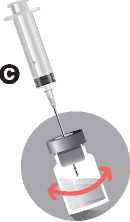
2c
Pull up Needle 1 above the liquid level. Do not remove the needle from the vial. Reconstitute the suspension, by swirling gently from side to side. Do not invert the vial.
Continue swirling long enough to obtain a homogeneous and milky suspension. Important: Check there is no unsuspended powder in the vial (if any powder clumps are present, continue swirling until they disappear).
4. AFTER USE
• Activation of the safety system using a one-handed technique.
• Note: Keep your finger behind the tab at all times.
There are two alternatives to activate the safety system:
• Method A: push the tab forward with your finger

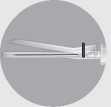
The presence of bubbles on top of the lyophilisate is a normal appearance of the product.
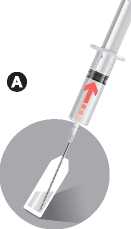
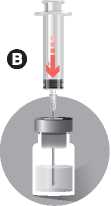

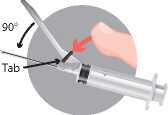
Method A
2a
Take out the ampoule containing the solvent. Tap any solution within the tip of the ampoule back to the main body of the ampoule.
Screw Needle 1 (without safety device) on to the syringe. Do not remove the needle protection yet.
Break open the ampoule with dot face up. Remove the needle protection from Needle 1. Insert the needle in the ampoule and draw up all the solvent into the syringe.
Put aside the syringe containing the solvent.
2b
Take out the vial containing the powder. Tap any powder which has accumulated at the top of the vial back to the bottom of the vial. Remove the plastic tab on top of the vial.
Take back the syringe containing the solvent, and insert the needle through the rubber stopper vertically into the vial. Inject the solvent slowly, so that, if possible, it washes down the entire upper part of the vial.
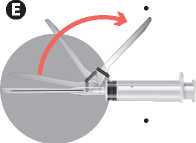
When the suspension is homogeneous, pull down the needle and without inverting the vial, draw up all of the suspension. A small amount will remain in the vial and should be discarded. An overfill is included to allow for this loss.
Grasp the coloured hub to disconnect the needle. Remove Needle 1 used for the reconstitution from the syringe. Screw on to the syringe Needle 2.
Move the safety sheath away from the needle and towards the syringe barrel. The safety sheath remains in the position you set.
Remove the needle protection from the needle.
Prime the needle to remove air from syringe and inject immediately.
3. INTRAMUSCULAR INJECTION
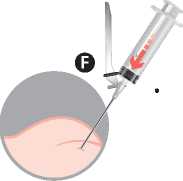
Toavoid precipitation, inject immediately into the gluteal muscle previously disinfected.
the
or
Method B: push the sheath to a flat surface
Press firmly
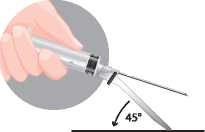
Method B
In both cases press down with a firm quick motion until a distinct audible click is heard.
Visually confirm that the needle is fully engaged under the lock.
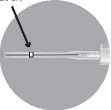
Used needles, any unused suspension or other waste materials should be disposed of in accordance with local requirements.
^ IP5EN ((
0459
